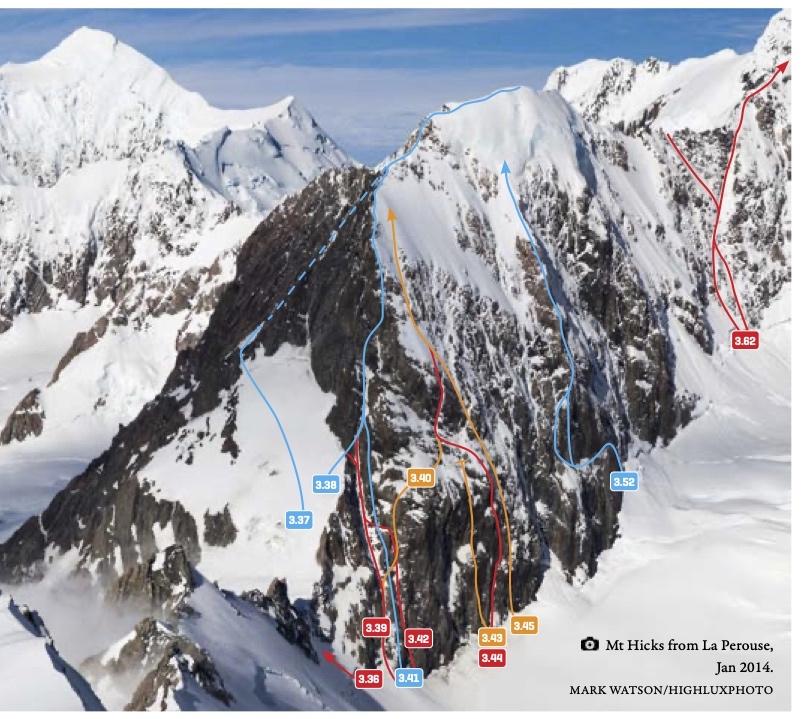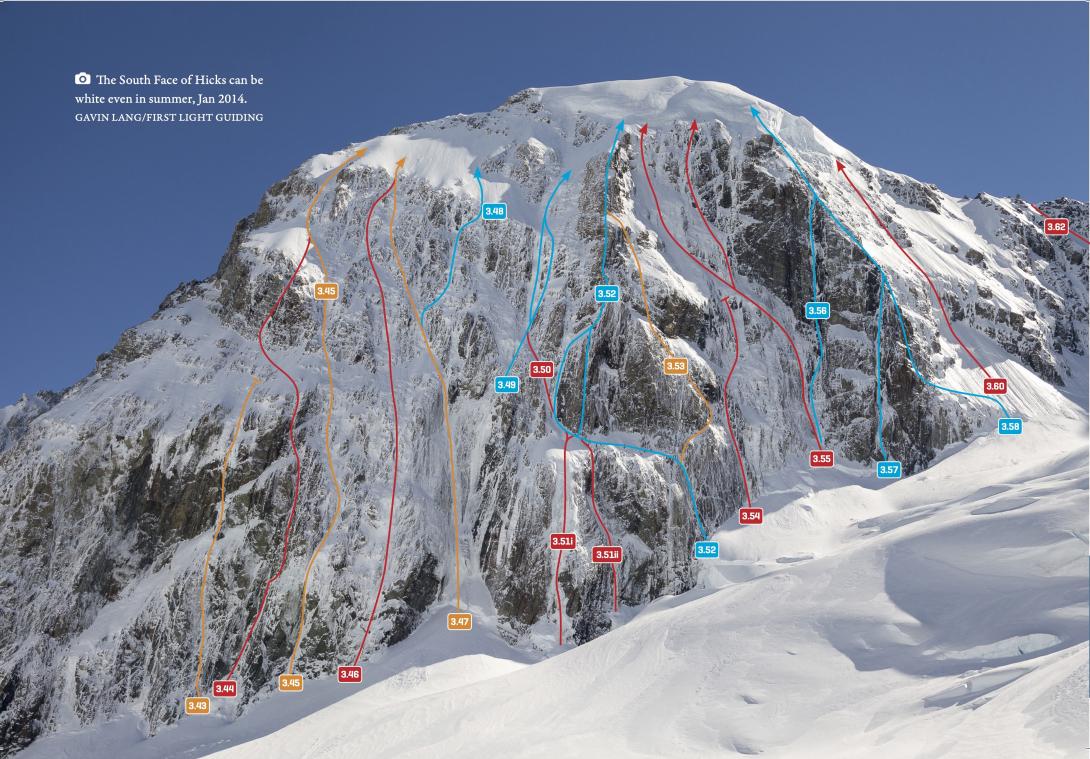The south face of Mt Hicks is the stuff of legend. Due to the face’s proximity to Empress Hut it is sometimes considered a large crag (‘large’ being the key word there). The face has some of the best hard climbing in the region; for most routes the first two to three pitches provide the crux.
There is no easy descent route from the top of Mt Hicks. If you’ve summited via one of the rock routes in summer, the best descent is probably Route 3.37. If you’ve climbed an ice route it’s probably easier to abseil on v-threads, either down the route you’ve climbed or down the Right Icefields (Route 3.60).
Routes
| Reference | Title | Grade | Length | Pro | Quality | Alert | Operations |
|---|---|---|---|---|---|---|---|
| 3.38 | 3.38Divide Route, IV,3+,3+ | IV,3+,3+ | 0m | ||||
|
From Harper Saddle, head up on snow to the left of the Divide for a short distance before crossing onto the edge of the South Face. Follow up ledges and bluffs overlooking the South Face until the Divide flattens out, then follow the ridge up the final 40m wall to the summit. The "modern way" would be to climb the complete Dingle/Button route (3.39).
|
|||||||
| 3.39 | 3.39Dingle-Button, II,3+,4- | II,3+,4- | 0m | ||||
|
This route is popular due to its accessibility and
|
|||||||
| 3.40 | 3.40Dance Commander, IV,4+,4+ | IV,4+,4+ | 0m | ||||
|
Start up Dingle-Button, traverse into Deardissima to
Starts up Dingle Button traverses into Deardissima to the shelf then finishes up Highway to Hell/Heavens Door. An easy way to the summit on moderate ground. |
|||||||
| 3.41 | 3.41Tales of Choss, III,4+,13,4+ | III,4+,13,4+ | 0m | ||||
Start at the bottom of the D-B couloir and climb the rib on the right of the gully (crux 13). Join the Divide Route after six rope lengths. |
|||||||
| 3.42 | 3.42Deardissima, 4 | 4 | 0m | ||||
|
Gully immediately right of Dingle-Button. Crosses
|
|||||||
| 3.43 | 3.43King Hit, IV,6,5+ | IV,6,5+ | 0m | ||||
|
Follows a line of weakness through the steep area just left of Highway to Hell. Cross the obvious right-trending ramp system between the second and third shelves, then climb the final headwall to reach an extensive area of easy ground half way up the left side of the face. The first ascentionists descended from here by traversing left downclimbing Dingle-Button. Five or six pitches.
|
|||||||
| 3.44 | 3.44Highway to Hell, V,5+,6 | V,5+,6 | 0m | ||||
Start just left of HD in a right trending gully on 65-85 degree ice (probably thin) then traverse right across a snowslope and step into a narrow gully. Follow the obvious gully and short steep walls. After the first shelf continue up a narrow gully to the second shelf and easy ground. Move left across the shelf then up right through the rock band to gain the summit icefield. Thirteen pitches. |
|||||||
| 3.45 | 3.45Heaven’s Door, V,5+,6 | V,5+,6 | 0m | ||||
|
This route aims for the prominent ice flow
|
|||||||
| 3.46 | 3.46The Curver Direct, V,5+,6- | V,5+,6- | 0m | ||||
|
This route seems to have been unaffected by the rockfall. The usual start is about 20-30m left of the very steep cliff on the left side of the rockfall gully, but there are a few different versions. Climb about five pitches of steep terrain to join Route 3.47 at an obvious small shelf.
|
|||||||
| 3.47 | 3.47The Curver Neo-classic, V,6,6- | V,6,6- | 0m | ||||
|
The lower half of the original Curver ‘Classic’
|
|||||||
| 3.48 | 3.48One for Pavle, V,5+ | V,5+ | 0m | ||||
|
A strong Slovenian team climbed the difficult
|
|||||||
| 3.49 | 3.49Gunbarrels, V,7,6,WI5 | V,7,6,WI5 | 0m | ||||
|
Pick a line up the upper-right region of the recent
Original: Up two difficult pitches, into the bottom of the Curver Gully, then up three pitches until a diagonal gully cuts back right to the foot of the prominent double ice couloirs (the Gunbarrels). The first two or so original pitches fell off in 1999. |
|||||||
| 3.50 | 3.50Yankee-Kiwi Couloir, V,6,6+ | V,6,6+ | 0m | ||||
|
When this classic route was first climbed it
Ascends the Direct Start of the Left Hand Buttress Route, then up a steep ice couloir to the left of the Left Buttress to the base of the Original Gunbarrels |
|||||||
| 3.51 | 3.51Left Buttress Direct Start, V,6,18,6 | V,6,18,6 | 0m | ||||
|
Climb directly to the ledge traversed by the
|
|||||||
| 3.52 | 3.52Left Buttress, V,6,15,5+ | V,6,15,5+ | 0m | ||||
|
Ascend two pitches on the bottom wall nearer the Central Gullies, then traverse left directly below the main buttress to reach an ice ramp left of the buttress. Then either ascend directly up the buttress crest (crux 15), or up the ramp for a short distance before regaining the buttress, or up a short buttress left of the ramp before cutting back right again. Follow the buttress up progressively easier rock until the icefields. Then, depending on the state of the icecliffs, traverse left and up, or else through the cliffs. Superb.
|
|||||||
| 3.53 | 3.53Desolation Row, VI,5+,6 | VI,5+,6 | 0m | ||||
|
Start up Route 3.52, then traverse slightly right
|
|||||||
| 3.54 | 3.54Generation Y, IV,6,WI4,M5 | IV,6,WI4,M5 | 0m | ||||
|
A variation direct start to Central Gullies. Start from a thin gully just
|
|||||||
| 3.55 | 3.55Central Gullies, V,5,6- | V,5,6- | 0m | ||||
|
The first of the big ice climbs on this face. There
There are a number of variation starts and finishes. Choose a start and head up ice, sustained climbing through ice couloirs and icefields until easier 45o slopes lead to the icecliffs. Depending on the state of the cliffs, find a route through them to the summit. |
|||||||
| 3.56 | 3.56Logan’s Run, V,6+,6+ | V,6+,6+ | 0m | ||||
|
One of the stand-out lines on the face,
|
|||||||
| 3.57 | 3.57Tingler, IV,6+,6+ | IV,6+,6+ | 0m | ||||
|
Ascend the lower of the two major vertical
|
|||||||
| 3.58 | 3.58Right Buttress, V,5,14,5 | V,5,14,5 | 0m | ||||
|
Avoid the first 60m by using the icefield on the
Avoid the first 60m by using the icefield on the right. Traverse onto the crest of the buttress then directly up on or right of the crest (crux 14). Then head up the icefields and through the icecliffs. |
|||||||
| 3.59 | 3.59Ice Trek, IV,5 | IV,5 | 0m | ||||
|
A good one if ice conditions are on (not threatened by ice cliffs) and you feel like something slightly harder than Route 3.60. Links the ice sections of the bluffs on the right side of the Right Buttress. The first ascentionists abseiled the route after gaining the top of the buttress.
|
|||||||
| 3.60 | 3.60Right Icefields, IV,4+,5 | IV,4+,5 | 350m | ||||
Climb through the bottom cliffs which usually have two pitches of hard climbing, then up a sustained shield of ice. There are a number of variations. [6-7 pitches to the ridge , approx 8 x 60m abseils.] |
|||||||

